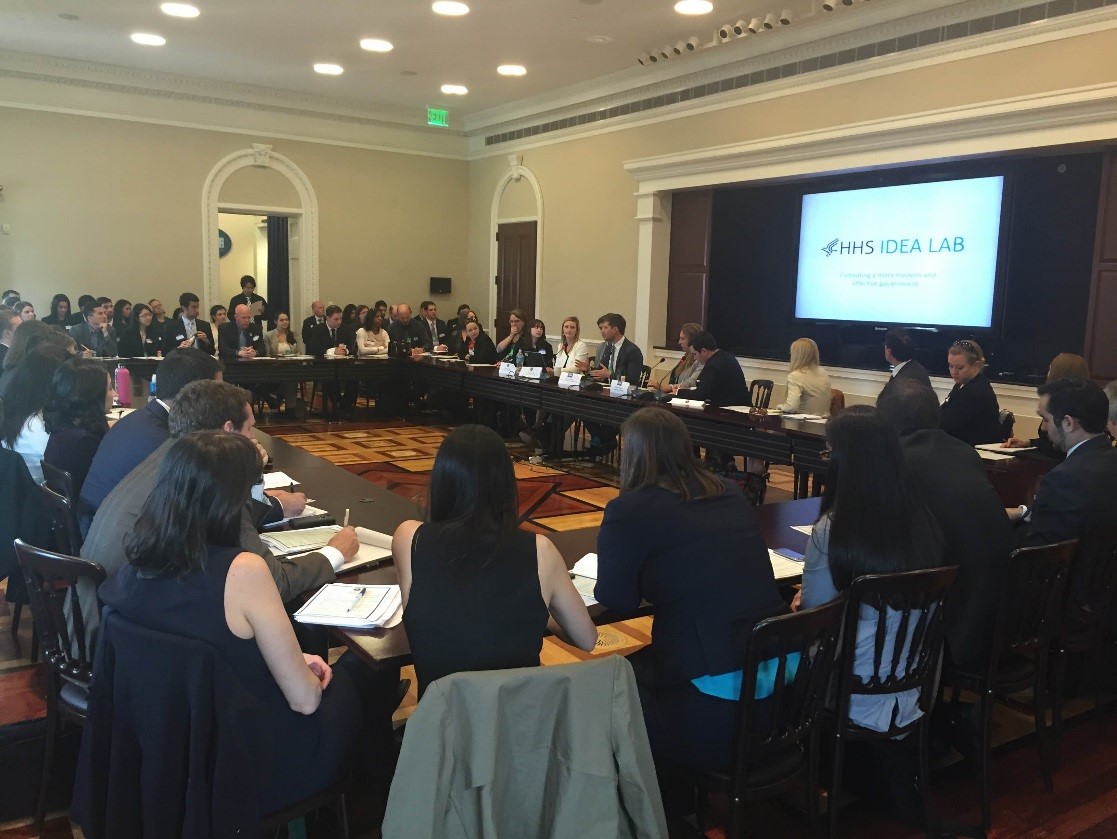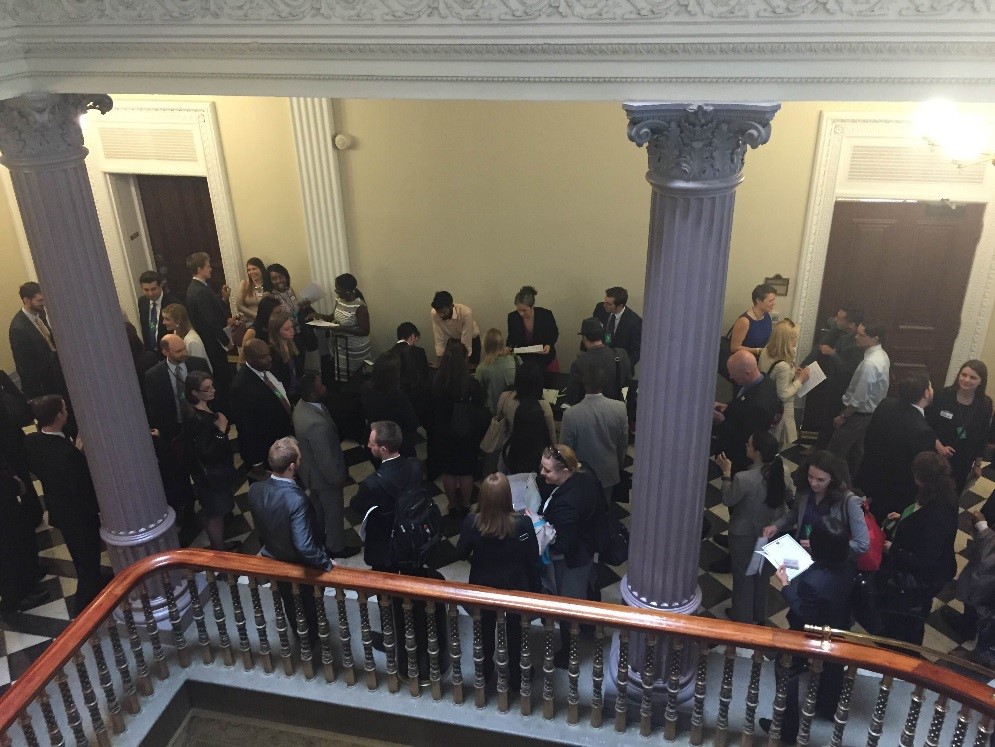
Participants in a variety of Federal fellowship programs bring enthusiasm, new ideas, and fresh perspectives to Federal departments and agencies every day. Last week, the Office of Science and Technology Policy (OSTP) convened a workshop to teach 100 current participants in Federal fellowship programs how to apply creative 21st-century tools to their fellowship projects, and to use these tools to inspire and ignite innovation in government.

100 current participants in almost a dozen Federal fellowship programs gathered at OSTP last week to learn more about innovation in government. (Photo credit: Noel Bakhtian)
In recent years, participants in a number of Federal fellowship programs – including Presidential Management Fellows (PMF), PMF STEM, AAAS Science and Technology Policy Fellows, and Presidential Innovation Fellows (PIF), among others – have successfully used a number of innovation approaches to help Federal departments and agencies more effectively meet their core mission goals. Examples of such approaches include:
- Use human-centered design and “Lean Startup” processes to significantly improve delivery of government services and the experience of interacting with the government.
- Make open data the default, and encourage entrepreneurs and developers to create compelling applications that take advantage of it.
- Use approaches to contracting (e.g., Other Transactions) that allow the Federal government to engage with entrepreneurial firms that can deliver more bang for the buck.
- Tap the distributed expertise of the American people in order to make better decisions, given the importance of Joy’s Law (“no matter who you are, most of the smartest people work for someone else”).
- Design an effective incentive prize that serves as a magnet for good ideas from start-ups and citizen inventors.
- Launch high-impact multi-sector collaborations involving companies, foundations, non-profits, researchers, regional initiatives, and skilled volunteers.
- Drive more Federal resources to support cost-effective interventions using an “experiment, validate, scale” approach to grant-making.
- Pay for outcomes, not inputs, and support policies and programs that are “more what and less how.”
Innovation approaches like these will be highlighted in the upcoming refresh of President Obama’s Strategy for American Innovation. The goal of OSTP’s workshop last week was to disseminate and pilot best practices for sharing these approaches with high-potential innovators across the government. Though fellows in Federal government are participating in a number of different programs and serving at a number of different departments and agencies, they often face similar roadblocks in achieving their goals, such as the challenges of learning the nuances of an agency, navigating the perceived and real boundaries of a workplace, and initiating, designing, and delivering on a new project. The fellows who participated in the workshop had the opportunity to network, share ideas, and learn about innovation approaches and other strategies for overcoming systemic barriers in government.

Before the program began, fellows met individuals who share interests and project goals across fellowship programs and agencies. (Photo credit: Noel Bakhtian)
The overwhelming interest in this event underscores the interest in and need for innovation across the Federal government. More than 300 current Federal fellows RSVPed in just three days for the workshop, and attendees represented a broad range of Federal fellowship programs, including AAAS Science and Technology Fellowship, PIF, PMF, ORISE Fellowship, Knauss Marine Policy, Albert Einstein Distinguished Educator, Truman-Albright, Consumer Financial Protection Bureau (CFPB) Tech & Innovation, Defense, and SunShot Science and Technology Policy.
The list of workshop presenters was equally diverse. In addition to structured panel presentations by innovation experts from the United States Agency for International Development (USAID), OSTP, Department of Health and Human Services (HHS), Department of Defense (DOD), Environmental Protection Agency (EPA), General Services Administration (GSA), US Department of Agriculture (USDA), Department of Veterans Affairs (VA), and the Department of Transportation (DOT), the event included perspectives of current fellows by way of case studies in short “lightning” talks. Mike Contreras, an AAAS fellow at DOE, discussed his experience designing and implementing the Sunshot Catalyst Program. Grace Hoerner, a PMF at USAID, discussed her experience designing prizes in support of the All Children Reading Grand Challenge, and Ashley Jablow, a PIF at the National Archives and Records Administration (NARA) discussed her experience applying human centered design and design thinking tools to the Federal archiving process.
The workshop was intended both to provide participants with actionable take-away knowledge about how to confront barriers within agencies, and to connect and empower fellows working in a variety of areas. It delivered on both goals. In reflecting on the event, Holly Crowe, a STEM PMF at DOD-DHA, mentioned: “In my agency rank is very important, and as someone who is just starting out, it can be hard to approach leaders with more experience than me with new ideas about how to do things. At this event I learned how to speak about innovation tools in more approachable terms and pitch my ideas with more empathy for leadership.” Lena Shi, a PMF at the Department of Education, added: “This event was an energizing reminder that regardless of which agency houses you or what your projects are, you have teammates in all corners of government who have the fire to build more creative and more meaningful solutions that work.”
Of equal importance, the event signaled that government work can be inspiring as well as challenging. As John Burchill, a PMF at GSA/FAS noted: "It's not often that you are invited to the White House to collaborate with colleagues across the government in an effort to spark innovation, share ideas, and meet like-minded forward thinking people looking to be catalysts of change." The power of bringing people together and providing them with the explicit tools and implicit confidence to enact their ideas continues to be one of the most effective strategies for progress in government. In the words of Alvand Salehi, a PMF at the DOE/ARPA-E: “The collective potential for innovation in that room was astounding. When you have over a hundred of the brightest minds gathered in one place, effectuating positive change is a foregone conclusion.”
Jenn Gustetic is Assistant Director for Open Innovation at the White House Office of Science and Technology Policy (OSTP).
Celestine Warren is an intern in the Technology and Innovation Division at OSTP.
Learn More:
- 21st Century Public Servants: Using Prizes and Challenges to Spur Innovation
- USAID’s Global Development Lab
- HHS’s IDEA Lab
- OPM’s Innovation Lab, design thinking in government
- Project Open Data
- Challenge.gov
Join an Innovation Community:

